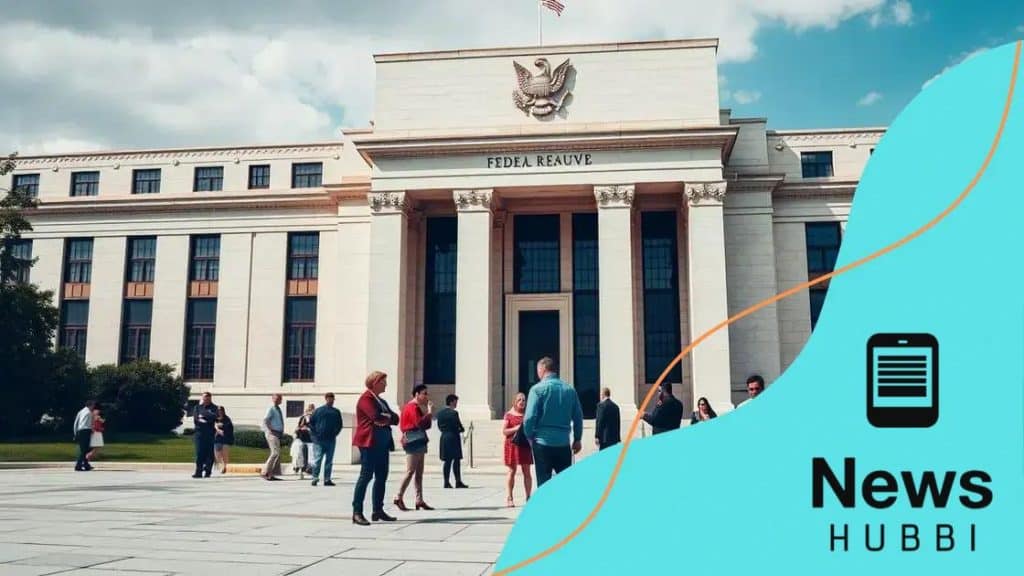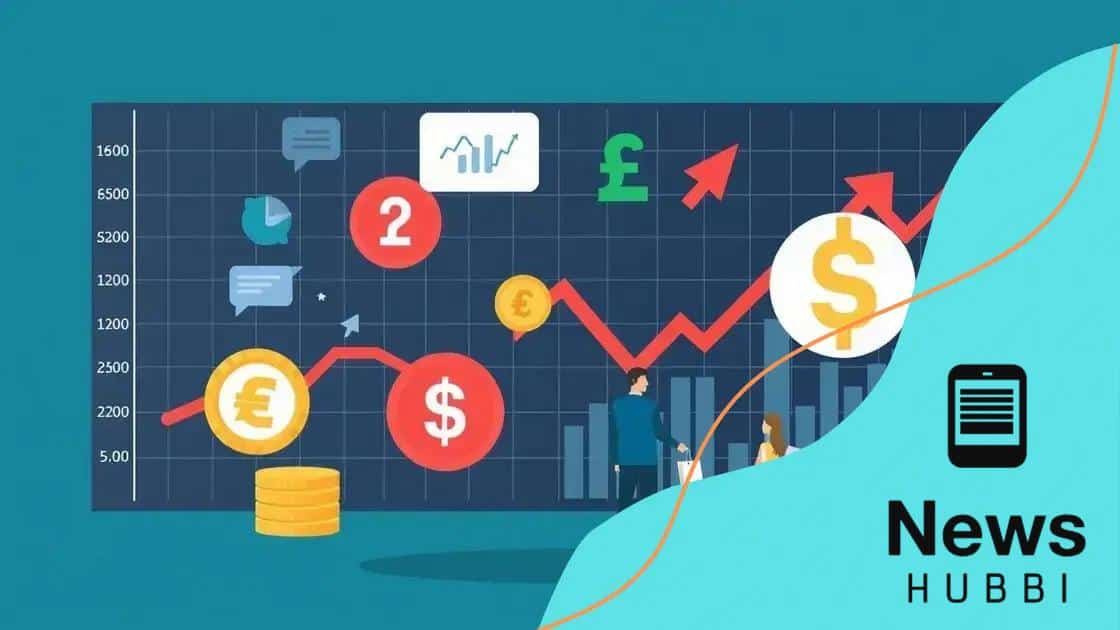Fed debates interest rate changes and their impact on you

Anúncios
The Fed debates interest rate changes primarily to manage inflation and sustain economic growth, which directly impacts borrowing costs and consumer spending habits.
The Fed debates interest rate changes, a topic that can significantly impact your financial decisions. Have you wondered how these shifts in rates might affect your savings or loans? Let’s dive into what this debate means for you.
Anúncios
Understanding the role of the Fed in the economy
Understanding the role of the Fed in the economy is crucial for anyone interested in finance. The Federal Reserve, often just called the Fed, plays a significant part in shaping our economic landscape.
The Functions of the Fed
One of the primary functions of the Fed is to manage monetary policy. This means adjusting interest rates and controlling the money supply to influence inflation and employment. By doing this, the Fed aims to promote a stable economy.
- Setting interest rates to influence borrowing and spending
- Monitoring and regulating banks to ensure financial stability
- Providing financial services to the government and financial institutions
- Managing inflation to maintain purchasing power
In addition to managing monetary policy, the Fed also has a role in supervision and regulation. It ensures that banks operate safely and soundly to protect consumers. The health of our banking system is vital for a stable economy. A strong banking sector supports businesses, families, and the overall economic structure.
Anúncios
The Impact of Fed Decisions
The decisions made by the Fed can ripple through the economy. For example, when the Fed raises interest rates, borrowing costs increase. This affects everything from auto loans to mortgages. Families may think twice before making large purchases, leading to a slowdown in economic activity.
On the other hand, when interest rates are lowered, borrowing becomes cheaper. This encourages spending and investment, which can stimulate the economy. However, too low of a rate for too long can lead to challenges like inflation. Understanding these dynamics is essential for informed financial planning.
In essence, the Fed’s actions have far-reaching effects, making it a key player in our economic system. By keeping a close watch on the Fed’s moves, consumers can better grasp how these decisions impact their own financial situations.
Key factors influencing interest rate decisions

Several key factors influence interest rate decisions made by the Fed. Understanding these factors can help you better anticipate changes that affect your financial landscape.
Economic Indicators
Economic indicators play a significant role in shaping the Fed’s decisions. These include metrics such as gross domestic product (GDP), unemployment rates, and inflation. When the economy is growing rapidly, the Fed may increase rates to prevent overheating. Conversely, if the economy is sluggish, a rate cut could stimulate growth.
- GDP Growth: Indicates how well the economy is performing.
- Unemployment Rates: High unemployment may prompt lower rates to encourage job growth.
- Inflation Rates: Rising prices may lead to rate hikes to keep inflation in check.
- Consumer Spending: This reflects confidence in the economy, impacting the Fed’s policy choices.
In addition to these economic indicators, the Fed also considers market expectations. Investors and analysts often speculate on how the Fed will act based on current economic data. These expectations can influence the Fed’s decisions and, ultimately, the behavior of interest rates.
Global Economic Conditions
Global events significantly impact the Fed’s interest rate decisions. A downturn in other countries can affect U.S. exports and lead to lower economic growth. Additionally, geopolitical tensions can create uncertainty, prompting the Fed to adopt more cautious policies.
The Fed also monitors international interest rates. When other countries raise or lower their rates, the Fed must consider the potential consequences for the U.S. economy. These interconnected factors all contribute to the complex decision-making process of the Fed.
By keeping an eye on these key factors, you can better understand the potential changes in interest rates that may affect your savings, investments, and loans.
Impacts of interest rate changes on consumers
The impacts of interest rate changes on consumers can be far-reaching. When the Federal Reserve alters rates, it can directly affect various aspects of personal finances.
Effect on Borrowing Costs
When interest rates rise, the cost of borrowing typically increases. This affects loans ranging from mortgages to personal loans. Higher rates mean higher monthly payments, which can make it tougher for consumers to afford purchases.
- Mortgages: Higher rates can lead to more expensive monthly mortgage payments, impacting home buying.
- Auto Loans: Increased interest rates can result in higher payments for car buyers, discouraging new purchases.
- Credit Cards: Borrowing on credit cards becomes pricier, as rates increase, leading to more debt.
- Student Loans: New loans may carry higher interest rates, making education more costly.
Conversely, when rates are lowered, borrowing becomes cheaper. This can lead to increased consumer spending, as people are more inclined to take out loans for big purchases like homes and cars. Lower rates can boost home sales and help stimulate the economy.
Impact on Savings and Investments
Interest rate changes also influence how people save and invest. When rates are low, consumers may find that savings accounts and fixed-income investments yield lower returns. As a result, this can lead to individuals seeking riskier investment opportunities in an attempt to achieve better returns.
In contrast, higher interest rates can provide better returns on savings accounts and other fixed-income investments. People might feel more secure keeping their money in savings, thus impacting their overall spending habits. It’s important for consumers to understand how these fluctuations can affect their financial strategies.
The impacts on consumer behavior show how closely interest rates are tied to economic health. Keeping an eye on these changes is essential for making informed financial decisions.
How interest rates affect loans and mortgages

Interest rates play a crucial role in determining the cost of loans and mortgages. When interest rates change, the implications can be significant for consumers looking to borrow money for their homes or personal needs.
Impact on Mortgage Payments
When interest rates rise, the cost of borrowing increases. This means that monthly mortgage payments will be higher for new loans. A small increase in the interest rate can result in a much larger sum paid over the life of the loan. Homebuyers may find themselves needing to adjust their budgets or even reconsider their purchasing decisions.
- Higher Monthly Payments: Increased rates can lead to unaffordable monthly expenses for buyers.
- Loan Affordability: As rates go up, the amount you can borrow may decrease.
- Refinancing Challenges: Existing homeowners may hesitate to refinance if new rates are higher than their current rates.
- Market Dynamics: A slowdown in mortgage applications can occur as potential buyers step back.
On the other hand, when interest rates are low, it can stimulate the housing market. Borrowing costs become more affordable, which may lead to a surge in home purchases and refinancing activity. This often results in greater competition among buyers and can drive home prices up.
Effects on Personal Loans
Similar principles apply to personal loans. When interest rates increase, those looking to acquire personal loans for things like car purchases or education will face higher repayment amounts. This can lead to potential borrowers being more selective about their loans, affecting their ability to finance important purchases.
Conversely, if rates are low, borrowers may feel encouraged to take out loans, promoting spending. This means that lower rates can energize the economy by encouraging consumers to invest in large purchases or renovations.
Understanding how interest rates affect loans and mortgages can empower consumers to make informed financial decisions. Keeping track of rate changes is essential for anyone considering a loan or mortgage, as it can ultimately impact their financial health.
Future outlook on Fed policies and market reactions
The future outlook on Fed policies and market reactions is a topic of great interest for both investors and consumers. Understanding potential changes in policy can provide insights into how the economy might behave.
Predictions for Interest Rates
Economists often analyze indicators to anticipate the Fed’s next moves. If inflation remains a concern, rates may continue to rise. This can affect borrowing, spending, and investment behaviors. Keeping an eye on key economic data can help forecast these changes.
- Inflation Trends: Rising inflation may prompt the Fed to increase rates further.
- Employment Reports: Strong job growth could lead to higher interest rates.
- Global Economic Influences: International events can shape the Fed’s decisions, affecting U.S. markets.
- Market Sentiment: Investor confidence can influence how the Fed adjusts its policies.
In addition to interest rate predictions, the Fed’s approach to communication plays a pivotal role. Transparent communication can help stabilize markets by setting expectations. When the Fed signals its intentions clearly, investors can make informed decisions based on that guidance.
Potential Market Reactions
Markets typically react to any shifts in Fed policy. If rates are increased, stock markets might experience volatility as investors reassess their strategies. Higher rates can lead to lower stock prices in the short term, as borrowing costs for companies rise.
On the flip side, if the Fed lowers rates or signals an easing approach, markets may respond positively. Lower rates generally encourage borrowing and spending, which can boost stock prices and investor confidence. Monitoring these reactions is essential for anyone involved in the market.
Ultimately, the future of Fed policies hinges on economic conditions. By staying informed about key indicators and market reactions, consumers and investors can navigate the changing financial landscape more effectively.
In conclusion, understanding how the Fed’s interest rate decisions affect the economy is crucial for consumers and investors alike. These rates influence borrowing costs, spending habits, and market reactions. By staying informed about key economic indicators and Fed policies, individuals can better navigate their financial choices and plan for the future. Watching these trends helps in making wise financial decisions, whether it’s buying a home, taking out a loan, or investing in the stock market.
FAQ – Common Questions About Interest Rates and the Fed
What impact do interest rate changes have on mortgages?
Interest rate changes directly affect the cost of borrowing, which can lead to higher monthly payments for mortgages.
How do interest rates influence consumer spending?
When interest rates are low, consumers are more likely to borrow and spend money, stimulating economic growth.
Why does the Fed change interest rates?
The Fed adjusts interest rates to manage inflation and support economic growth, ensuring financial stability.
How can I stay informed about Fed policies?
You can follow economic news, subscribe to financial newsletters, or visit the Fed’s official website for updates and reports.





